Young Person's Guarantee - employment and education landscape: current evidence - overview
This evidence paper provides an overview of the current evidence on the employment and education landscape for young people aged 16 to 24 in Scotland, with equalities and Scottish Index of Multiple Deprivation (SIMD) breakdowns provided where possible.
6. Apprenticeships
This chapter examines the available information on Foundation Apprenticeship (FA), Modern Apprenticeship (MA) and Graduate Apprenticeship (GA) provision in Scotland.
MA and GA sections focus specifically on 16 to 24 year olds, however, as with school leaver destinations data presented in Chapter 3, FA statistics have not been broken down by age as most of those participating are senior phase school pupils, although it is worth noting some of the participants will be under the age of 16.
Foundation Apprenticeship starts, achievements and destination
Foundation Apprenticeships (FA) were first introduced in 2016 to provide work-based learning opportunities for secondary school pupils making their senior phase subject choices. They are delivered through partnerships between schools, a local college, or learning provider and local employers, and support learner pathways into jobs, including MA and GAs, and into Further and Higher Education. This differs from MAs and GAs which are considered full-time paid employment.
Until recently (cohorts 1-3) FAs provided qualifications at SCQF Level 6 which is the same level of learning as a Higher. More recently (cohorts 4-5), further pilot work has extended the offer at SCQF Levels 4 and 5.[46]
Chart 6.1 provides the number of FA starts by year (cohort) and level. It shows that there was a steady increase in FA starts across the first four years of delivery, with the number rising from 346 in 2016 to 3,450 in 2019 at SCQF Level 6. However, the FA uptake at this level decreased during the pandemic in 2020, with number of starts falling to 2,975.
The number of pupils undertaking Pilot FAs at SCQF level 4/5, however, saw a considerable increase between 2019 and 2020, rising from 442 to 1,265, respectively, as they were rolled out across more Local Authorities and schools.
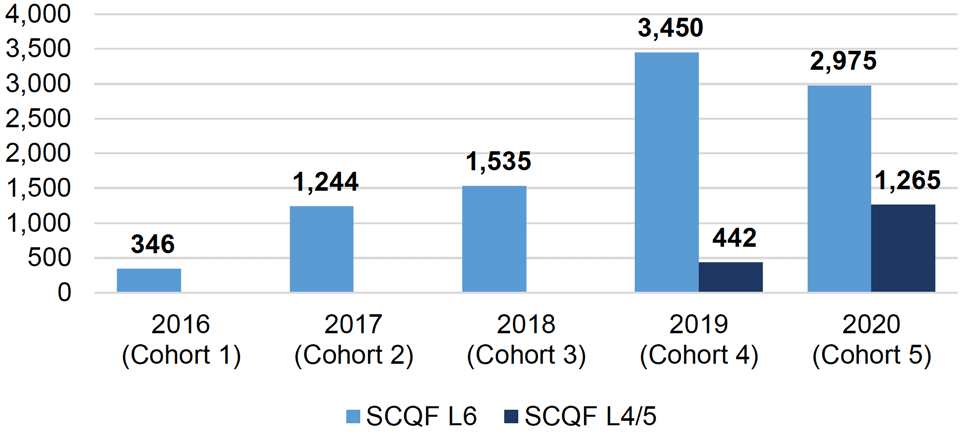
Source: SDS (June 2021), Foundation Apprenticeships Progress Report.
Table 6.1 shows FA starts relative to completers and achievers[47] for cohorts 1-3 between 2016 and 2018[48]. In 2018, just over half (55.6%) of those who started in cohort 3 completed their FA programmes. In 2018, 46.6% of the starts and 83.7% of all completers gained a full achievement.
While not presented here, some pupils leave their FA programmes with partial achievements, such as National Progression Award, National Certificate or SVQ units, which are certified through SQA.[49]
| 2016 (Cohort 1) | 2017 (Cohort 2) | 2018 (Cohort 3) | |
|---|---|---|---|
| Starts | 346 | 1,244 | 1,535 |
| Completers | 154 | 652 | 854 |
| Full achievers | 129 | 502 | 715 |
| Partial achievers | 146 | 501 | 557 |
| Completers as a % of starts | 44.5 | 52.4 | 55.6 |
| Full achievers as % of starts | 37.3 | 40.4 | 46.6 |
| Full achievers as % of completers | 83.8 | 77.0 | 83.7 |
Source: SDS (June 2021), Foundation Apprenticeships Progress Report.
Table 6.2 looks at the FA leaver destinations. College was the most popular destination for full achievers in 2016 and 2017 (49.6% and 43.4%). However, in 2018, more achievers moved into university than college (42.2% compared to 34.3%). In 2018, 18.9% of full FA achievers went into employment or started an MA.
| 2016 (Cohort 1) | 2017 (Cohort 2) | 2018 (Cohort 3) | |
|---|---|---|---|
| Full Achievers | |||
| Other FA | - | - | - |
| Employment or MA | 27.1 | 22.3 | 18.9 |
| College | 49.6 | 43.4 | 34.3 |
| University | 19.4 | 29.1 | 42.2 |
| Other Training | * | * | - |
| Remain in school | - | 3.6 | 3.4 |
| Unemployed | * | * | 1.3 |
| Unknown | - | - | - |
| Partial Achievers | |||
| Other FA | - | * | * |
| Employment or MA | 28.1 | 24.2 | 22.4 |
| College | 19.2 | 28.5 | 27.1 |
| University | 6.2 | 6.2 | 9.2 |
| Other Training | 3.4 | 2.0 | 1.1 |
| Remain in school | 40.4 | 36.9 | 37.2 |
| Unemployed | * | 1.2 | * |
| Unknown | * | * | 1.1 |
Source: SDS (June 2021), Foundation Apprenticeships Progress Report.
*Disclosure control has been applied where figures are less than 5 or where such small numbers can be identified through differencing.
Foundation Apprenticeship starts[50] by equalities and SIMD
SIMD
In 2020 there was a reasonably even spread of starts among pupils across all SIMD areas at SCQF Level 6, with pupils slightly more likely to be from less deprived areas. However, for those undertaking a FA at SCQF level 4/5, pupils are more likely to be from more deprived areas, with 12.6% from 10% most deprived and 3.5% from 10% least deprived areas.[51]
Equalities
Since FAs were introduced in 2016, there has been a steady growth in the proportion of female FA starts at SCQF Level 6, rising from 49.7% in 2016 to 58.0% in 2020. According to SDS, part of this change relates to the frameworks that were available in 2016, relative to 2020.
The proportion of pupils self-declaring a disability has seen a 9.3 pp increase since the start of the FA programme, rising from 7.1% to 16.4% in one year between 2018 and 2019, respectively. According to SDS, there is no obvious explanation for this increase, however improvements in reporting are likely to have had a positive impact. The rate has continued to increase by 1.2 pp between 2019 and 2020.
The proportion of minority ethnic FAs increased by 1.5 pp between 2016 and 2019, from 4.9% to 6.4%, respectively. The proportion saw a minor, 0.1 pp decrease between 2019 and 2020. At 6.4% this exceeds the Scottish population share.
| 2016 Cohort 1 | 2017 Cohort 2 | 2018 Cohort 3 | 2019 Cohort 4 | 2020 Cohort 5 | |
|---|---|---|---|---|---|
| Female | 49.7 | 53.7 | 56.6 | 57.0 | 58.0 |
| Male | 50.3 | 46.3 | 43.4 | 43.0 | 42.0 |
| Self-declared disability | 8.0 | 7.4 | 7.1 | 16.4 | 17.6 |
| Minority ethnic | 4.9 | 5.0 | 6.2 | 6.5 | 6.4 |
| Care experienced | 1.3 | 7.8 | 5.1 | 2.4 | 2.8 |
Source: SDS (June 2021), Foundation Apprenticeships Progress Report.
FA starts in the Pilot SCQF Level 4/5 are dominated by male pupils, with the male share of starts at 88.5% in 2019 and 82.5% in 2020. This is likely due to the scope of the available subject areas, some of which have long engrained gender segregation issues.
The proportion of FAs at SCQF Level 4/5 self-declaring a disability rose by 8.2 pp from the initial pilot in 2019 (17.1%) to the 2020 (25.3%) intake. It is likely that this increase is at least partly due to levels 4 and 5 being available to a broader range of pupils. The SDS definition of disabled also includes those with Additional Support Needs and Learning Difficulties, which could explain the large proportion of FAs self-declaring a disability. Of those pupils studying at SCQF level 4/5 in 2020 who self-identified a disability, the categories with the biggest proportions were: learning disability (60.0%), social communication impairment (18.6%) and mental health (10.4%).
The proportion of minority ethnic pupils at SCQF Level 4/5 is lower, at 2.4% in 2020 (increased slightly from 2.1% in 2019). Although there are now more schools offering pilot FAs at this level, they are not yet available in every local authority, which may make them less accessible to minority ethnic pupils.
Gender balances across FA frameworks/subject areas and in STEM related courses
As with colleges and universities gender balances vary between subject areas. For SCQF level 6 females tend to dominate social services frameworks and males are most prevalent in engineering and IT frameworks. While at SCQF levels 4 and 5, male pupils dominate Construction and Automotive frameworks/subjects, with only hospitality showing a slight female majority (see charts 6.2 and 6.3).
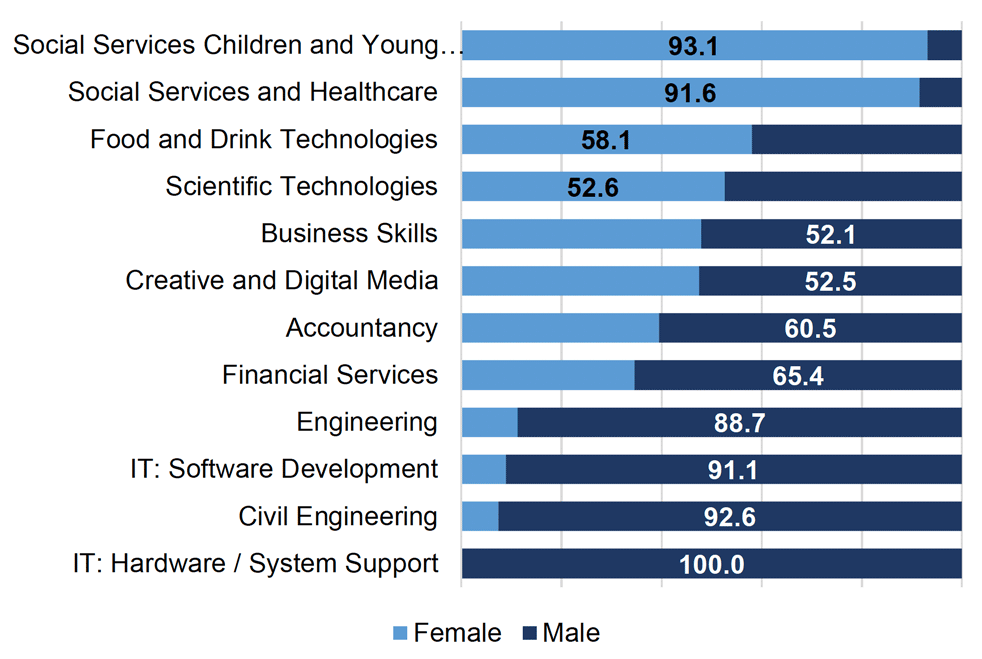
Source: SDS (June 2021), Foundation Apprenticeships Progress Report.
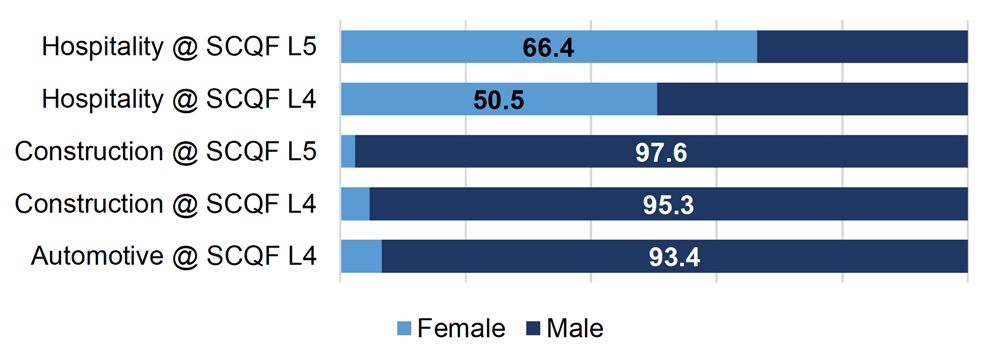
Source: SDS (June 2021), Foundation Apprenticeships Progress Report.
017r share of FA startsreas, some of which have long engrained gender segregation issues.pe of the available subject areas, wh
STEM related frameworks/subject areas have a considerable male majority. The gap has been narrowing for SCQF level 6 FAs, with female share in STEM having increased from 8.1% in 2016 to 24.5% in 2020. At SCQF Levels 4/5 males currently represent 95.5% of STEM related frameworks/subject areas, and females 4.4%.[52]
Modern Apprenticeship (MA) starts aged 16 to 24
The number of MA starts aged 16 to 24 has been decreasing since 2015/16, falling from 20,506 to 17,101 in 2019/20, a 16.6% drop (see Chart 6.4). At the same time, the number of all MA starts has consistently increased due the increasing amount of MA starts aged 25 and above, with the share of young people as a proportion of total MA starts falling by 18.4 pp, from 79.7% in 2014/15 to 61.3% in 2019/20.
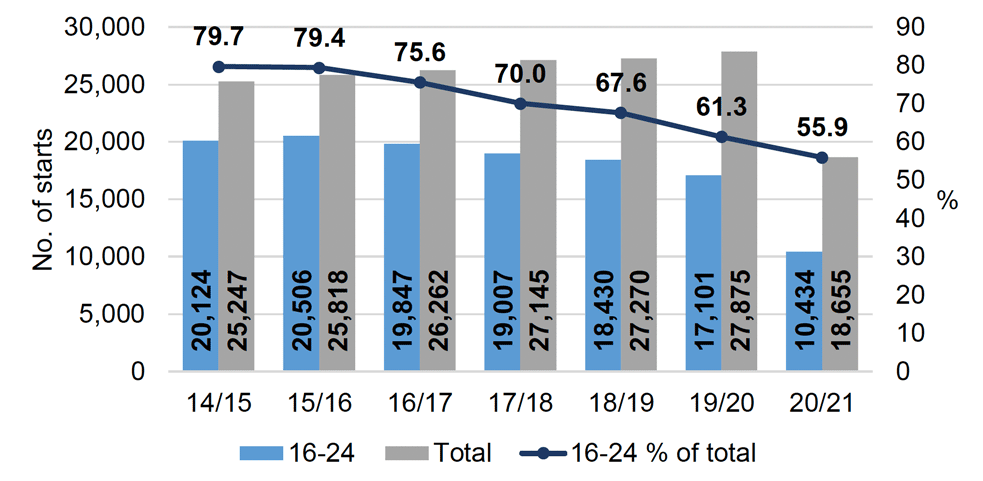
Source: SDS (2021), 'Modern Apprenticeship Supplementary Tables, Quarter 4, 2020/21'.
In 2020/21, the number of starts across all age groups decreased compared to 2019/20, primarily due to the Covid-19 pandemic. Covid-19 fundamentally changed the context in which employers make decisions about recruitment and staff learning, and in which apprenticeship training is delivered. Following a complete shut down during the first quarter of the year and the varying degrees of lockdown that followed, Scotland's businesses and particularly the sectors including tourism, hospitality and retail where, under normal circumstances, take up of apprenticeships would be high, have been hit hard.
The younger age groups were disproportionately affected during this year, with the share of young people as a proportion of total MA starts falling even further, to 55.9%. This decrease may be in part due to the ongoing adverse effects of the pandemic on young people, with employers less able to recruit young people into retail and hospitality, where they tend to dominate, because of social distancing and the turndown in business activity. It could also, in part, relate to the decline in 16 to 24 year old population over recent years, highlighted in Chapter 1 of this paper, as well as the relative increase in the proportion of MAs aged 25 and over.
In both 2019/20 and 2020/21, the majority of MA starts were at SCQF level 6 or above. The proportion of starts at level 6 and above increased by 6.6 pp, from 72.5% in 2019/20 to 79.1% in 2020/21. However, the number of MA starts at level 6 and above fell from around 12,400 to around 8,250, consistent with the overall reduction in starts due to the pandemic.[53]
Equalities and SIMD
The proportion of young MA starts who live in the 20% most deprived areas is higher than for those who reside in the 20% least deprived areas (see Table 6.4). Over the last few years, the gap between starts from the most and least deprived has gradually narrowed, falling from 9.8 pp in 2017/18 to 4.9 pp in 2020/21.
Men have consistently made up the largest share of MA starts aged 16 to 24, with 58.9% male in 2020/21 and 41.1% female. This is similar for the total MA starts (60.3% male, 39.8% female). While the gender balance of total MA starts has remained relatively constant historically, the gap between young male and female MA starts has been gradually widening.
The proportion of those self-identifying an impairment, health condition or learning difficulty has been rising between 2017/18 and 2019/20, from 12.3% to 17.1%. However, this proportion fell to 15.4% in 2020/21 and could be a demonstration of the impact of the pandemic on this group.
There has been no change in the share of MA starts who self-identify as minority ethnic. As shown in Chapter 1 of this evidence paper, the Participation Measure demonstrates that there is a higher rate of 16 to 19 year olds from minority ethnic groups who participate in Further and Higher Education, on leaving school. This, according to SDS[54], in part, explains their lower levels of representation in Modern Apprenticeships.
| 2017/18 | 2018/19 | 2019/20 | 2020/21 | |
|---|---|---|---|---|
| SIMD: 20% most deprived | 24.1 | 23.4 | 22.6 | 20.6 |
| SIMD: 20% least deprived | 14.3 | 14.6 | 15.1 | 15.7 |
| Female | 43.3 | 42.4 | 41.7 | 41.1 |
| Male | 56.7 | 57.6 | 58.3 | 58.9 |
| Self-declared disability | 12.3 | 15.2 | 17.1 | 15.4 |
| Minority ethnic | 1.8 | 2.2 | 2.2 | 2.2 |
| Care experienced | 1.8 | 1.7 | 1.7 | 2.0 |
Source: SDS (2021), 'Modern Apprenticeship Supplementary Tables, Quarter 4, 2020/21'; SIMD data is SG analysis of SDS Modern Apprenticeships data.
Gender balances
Gender balances vary depending on occupational groupings (see chart 6.5). In 2020/21 Administration and Related (74.3%), Personal Services (92.9%) and Sport, Health and Social Care (89.2%) groupings had a higher proportion of females overall whereas Animal Care, Land and Water (76.6%), Automotive (96.6%), Construction and related (98.4%), Engineering and Energy Related (94.4%), Other Manufacture (91.8%) and Transport and Logistics (88.2%) groupings had a higher proportion of males overall. Four out of nine occupational groupings that were male dominated in 2020/21 had over 90.0% male majority, whereas only one out of eight female dominated groupings had over 90.0% female majority.
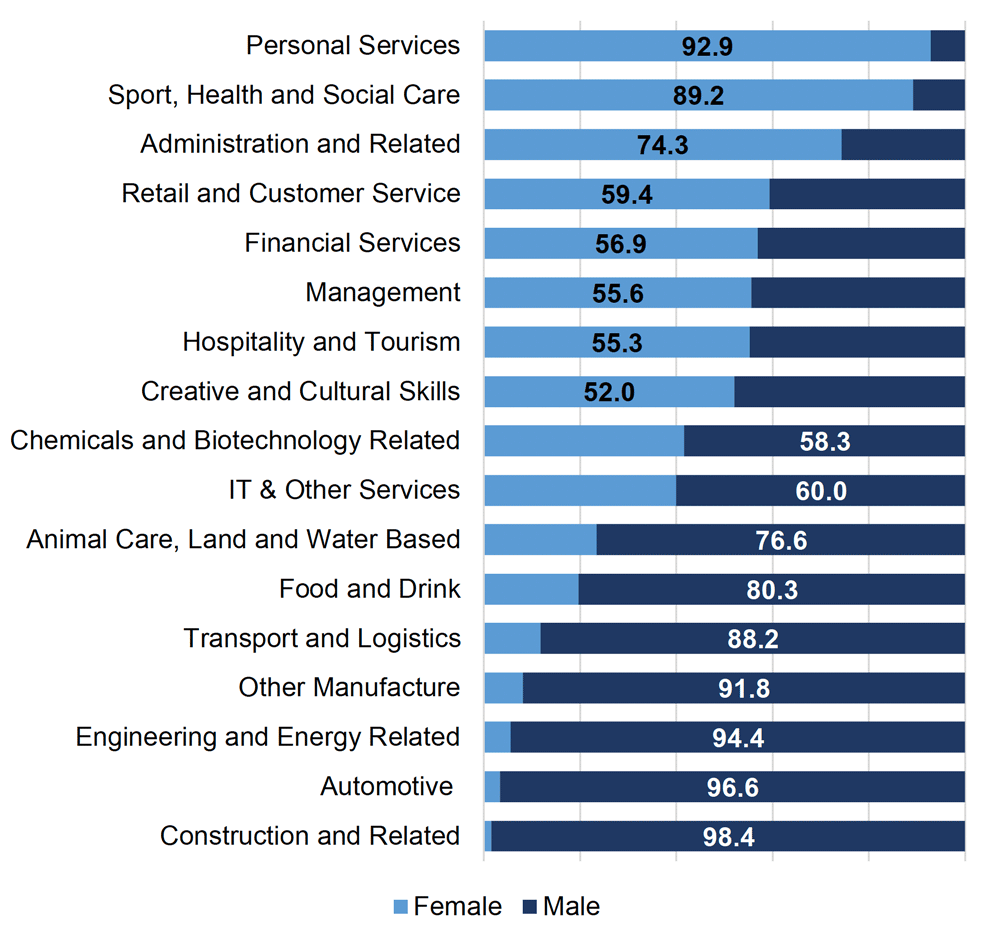
Source: SG analysis of SDS Modern Apprenticeship Statistics.
STEM subjects are particularly male dominated. In 2020/21, 87.4% of STEM starts were male and 12.6% were female. Whilst the gender gap in total MA starts has been widening the gender imbalances in STEM starts has shown some, albeit slow, signs of narrowing with the male share of STEM starts falling by 2.1 pp from 89.6% in 2017/18 to 87.4% in 2020/21.[55]
MA achievers aged 16 to 24
The achievement rate for 16 to 24 year olds has been falling in recent years, from 77.1% in 2016/17 to 74.8% in 2019/20, though rising again to 75.4% in 2020/21.
Those who live in the 20% least deprived areas have a higher MA achievement rate (79.2% in 2020/21) than those who come from the 20% most deprived areas (72.2% in 2020/21). This is consistent with college statistics covered in Chapter 4 of this paper.
Young women tend to have a higher achievement rate than young men – 76.0% and compared to 74.9% in 2020/21, respectively.
The achievement rate for those self-identifying as disabled is considerably lower than for those with no disability – 68.7% compared to 76.4%, respectively, in 2020/21. The gap between those identifying as disabled and those who do not was narrowing until 2019/20, falling from 12.2 pp in 2017/18 to 6.4 pp, however rising again to 7.7 pp in 2020/21.
Those self-identifying as minority ethnic have a lower achievement rate than those self-identifying as white (71.3% vs 75.3% in 2020/21). This differs slightly from the overall (all ages) MA achievement rates for those from minority ethnic communities, where the gap is much smaller (75.2% vs 76.4% in 2020/21), suggesting that this is a particular issue for the younger age groups. No improvement has been seen in the achievement rate for those from minority ethnic communities in the past four years.
The achievement rate for care experienced MAs is considerably lower than for those who are not (58.6% compared to 75.3% in 2020/21).This reflects a similar trend to other sources such as the Education Outcomes for Looked After Children which shows that looked after young people in Scotland tend to have poorer outcomes including lower attainment and fewer securing positive destinations.
When examining by SCQF levels[56], achievement rates tend to be higher for those with higher levels of qualification. For example, the achievement rate at SCQF levels 5 and 6 were 68.5% and 68.9% in 2020/21, compared to 86.6% and 83.1% at SCQF levels 8 and 9. Levels 10 and 11 have a 100.0% achievement rate, however this may be due the very small number (less than 5) of leavers and achievers at this level.
| 2017/18 | 2018/19 | 2019/20 | 2020/21 | |
|---|---|---|---|---|
| Total | 76.8 | 75.0 | 74.8 | 75.4 |
| SIMD: 20% most deprived | 73.9 | 71.4 | 71.6 | 72.2 |
| SIMD: 20% least deprived | 80.1 | 77.9 | 77.3 | 79.2 |
| Female | 76.8 | 75.0 | 75.9 | 76.0 |
| Male | 76.7 | 75.0 | 74.0 | 74.9 |
| Self-declared disability | 66.0 | 66.5 | 69.4 | 68.7 |
| Not disabled | 78.1 | 76.3 | 75.8 | 76.4 |
| Minority ethnic | 71.4 | 72.9 | 70.9 | 71.3 |
| White | 77.2 | 75.2 | 74.9 | 75.3 |
| Care experienceda | - | - | 61.4 | 58.6 |
| No care experiencea | - | - | 74.8 | 75.3 |
Source: Total and Gender data from SDS (2021), 'Modern Apprenticeship Supplementary Tables, Quarter 4, 2020/21'; SIMD, Disability and Care experience data is SG analysis of SDS Modern Apprenticeship data.
aData with care experience breakdowns only available from 2019/20 onward as this is the first year the dataset is complete.
MA redundancies and re-entrants aged 16 to 24[57]
There were 734 16 to 24 year old MAs made redundant in 2020/21. This is more than double the amount of MA redundancies made in 2019/20 (343) for this age group. This is likely to be due to the adverse impact of the pandemic.
There were also 303 re-entrants following redundancy in 2020/21. Similarly to redundancies, this is double the number of re-entrants in 2019/20 (151). Re-entrants following redundancy includes individuals supported through Adopt an Apprentice.
Destinations for those who have finished their Modern Apprenticeships
SDS does not, on a regular basis, collect data on destinations after the individual has left their MAs. However, they published a report on Modern Apprenticeship Intermediate Outcomes[58] in 2016 based on analysis of a telephone survey of 2,000 MAs in Scotland, who had left their apprenticeship around six months previously which provides some idea of outcomes after MAs for those aged 16 to 24.
This report shows that those in either work or education is relatively equally spread across age groups, with 94% of those aged over 25 and 20 to 24 and 92% of those aged under 20 in work or education.
Graduate Apprenticeship (GA) starts aged 16 to 24
The number of GA starts aged 16 to 24 increased between 2017/18 and 2019/20, from 162 to 503, respectively (see Chart 6.6). However, the growth has been slower than for older age groups, with the share of 16 to 24 year old starts as a proportion of total GA starts consistently falling from 58.5% in 2017/18 to 39.7% in 2020/21.
While the number of GA starts in older age groups remained relatively stable or increased, the 16 to 24 age group saw a fall from 503 in 2019/20 to 460 in 2020/21.
As reported by SDS[59], the trends in the increasing number of older GA starts compared to younger age groups could be linked to work-based learning likely attracting older, more experienced employees as a means of up-skilling, whereas younger age groups may be more attracted to the freedom and lifestyle that full-time study provides.
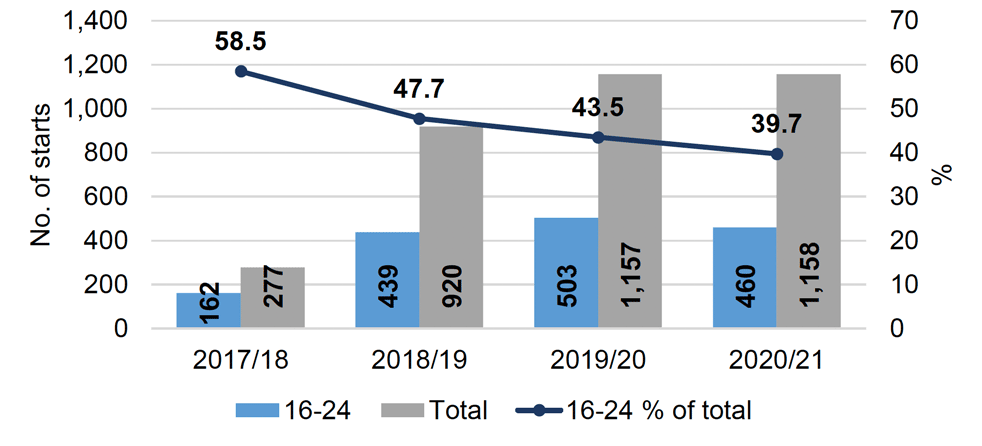
Source: SDS (2021), 'Graduate Apprenticeships Progress Report'.
Equalities
There is a considerably higher proportion of GA starts aged 16 to 24 from the least deprived areas compared to those from the most deprived areas: 12.8% compared to 26.7%, respectively, in 2020/21 (see Table 6.6). This is consistent with data on university enrolments highlighted in Chapter 5. However, there was a 2.5 pp increase in the proportion of those from 20% most deprived areas, rising from 10.3% in 2019/20 to 12.8% in 2020/21, while the proportion of starts from the 20% least deprived areas saw a 0.5 pp fall from 27.2% to 26.7% over the same time period.
There has been a consistent male majority in GA starts aged 16 to 24, although the gap has been slowly narrowing. The female share of GA starts has increased by 19.2 pp in the past four years, from 13.0% in 2017/18 to 32.2% in 2020/21.
The proportion of those aged 16 to 24 self-declaring a disability has increased between 2017/18 to 2019/20, from 4.1% to 11.4%, respectively. However, the proportion has fallen by 1.7 pp to 9.7% in 2020/21. This is consistent with overall GA figures.
The proportion of 16 to 24 year old GAs self-identifying as minority ethnic has remained relatively constant at just below 5% across the past three years[60]. This differs from the overall GA start figures which include all age groups, where the proportion of those self-identifying as minority ethnic has increased from 3.5% in 2018/19 to 5.2% in 2020/21.
| 2017/18 | 2018/19 | 2019/20 | 2020/21 | |
|---|---|---|---|---|
| SIMD: 20% most depriveda | - | - | 10.3 | 12.8 |
| SIMD: 20% least depriveda | - | - | 27.2 | 26.7 |
| Female | 13.0 | 27.6 | 29.0 | 32.2 |
| Male | 87.0 | 72.4 | 70.8 | 67.8 |
| Self-declared disability | 4.1 | 7.3 | 11.4 | 9.7 |
| Minority ethnic | * | 4.7 | 4.4 | 4.8 |
Source: SG analysis of SDS Graduate Apprenticeships Statistics.
aData is only available from 2019/20 onwards.
*Disclosure control has been applied where figures are less than 5 or where such small numbers can be identified through differencing.
Gender balances across GA frameworks[61]
As with MAs, gender balances vary across GA frameworks. Most GA frameworks (10 out of 13) are STEM related.
There are four GA Frameworks where disclosure control has not been applied that were female dominated: Accounting (Pilot), Early Learning and Childcare, Business Management and Civil Engineering Level 8[62]. The first three of these frameworks are non-STEM. All the seven male dominated frameworks, where disclosure control has not been applied, are STEM.
While the gender imbalances in GA frameworks are large, the female share has been increasing in some, consistent with the overall increases in the female share of all 16 to 24 year old GA starts. For example, the female share rose from 37.5% in 2019/20 to 42.1% 2020/21 in Data Science and from 25.0% to 38.5%, in IT Management for Business. Similarly, the female share in Accounting and Business Management, which were already female dominated, has increased.
In other STEM related frameworks, gender imbalances have shown very little improvement, with one, Construction and the Built Environment, showing signs of becoming even more male dominated, with the female share falling from 27.6% in 2019/20 to 23.1% in 2020/21.
However, these figures should be interpreted with caution, as the number of starts in each framework is relatively low.
Early leavers from Graduate Apprenticeships aged 16 to 24
A Graduate Apprentice is categorised as an early leaver if they leave their apprenticeship before achieving the full qualification they were registered for. Early leavers also include those who exit at a recognised point (e.g. achieve a qualification at SCQF level 9 rather than 10).
The percentage of 16 to 24 year old GA entrants who are early leavers is decreasing year on year. This is likely at least partially due to the elapsed time for each cohort, as would be expected, but, according to SDS, it may also reflect the continued evolution and maturity of GAs.
The share of 16 to 24 year old early leavers as a proportion of all leavers is also decreasing, suggesting that leavers are increasingly likely to be from older age groups.
| 2017/18 | 2018/19 | 2019/20 | 2020/21 | |
|---|---|---|---|---|
| % of all 16-24 GA starts | 21.0 | 19.1 | 13.7 | 3.0 |
| % of all early leavers | 42.5 | 36.8 | 37.5 | 31.8 |
Source: SG analysis of Graduate Apprenticeships Statistics provided by SDS.
GA achievers aged 16 to 24
Other than Civil Engineering at level 8 taking two years to complete and Early Learning and Childcare at Level 9 taking three years to complete, all GA frameworks are 4-year degree programmes. This means that, to date, only a very small number of students have achieved their full GAs.
There have been 58 achievers to date aged 16 to 24, 8 (13.8%) of which were female and 50 (86.2%) male.[63]
Contact
There is a problem
Thanks for your feedback